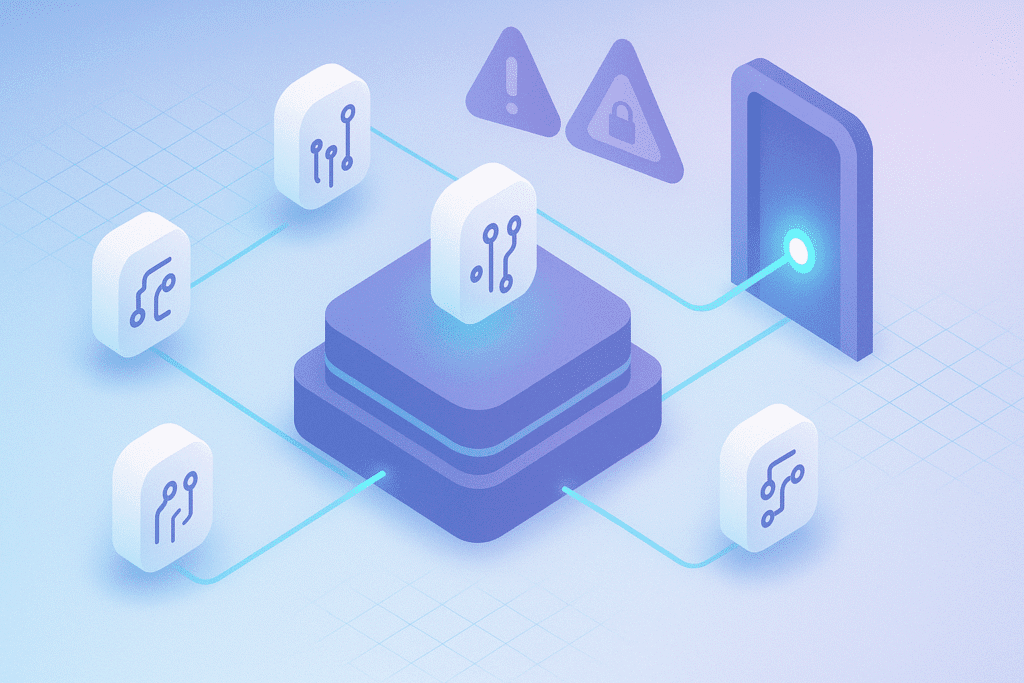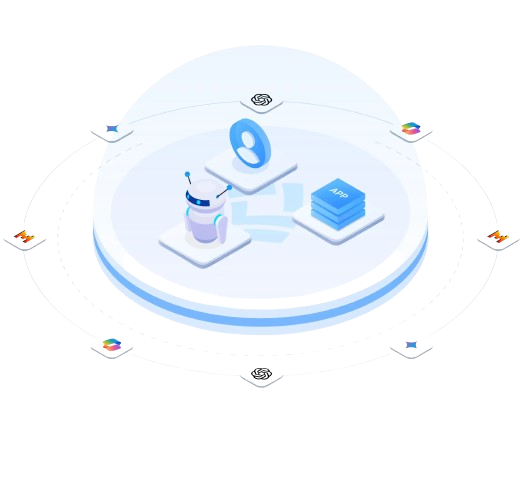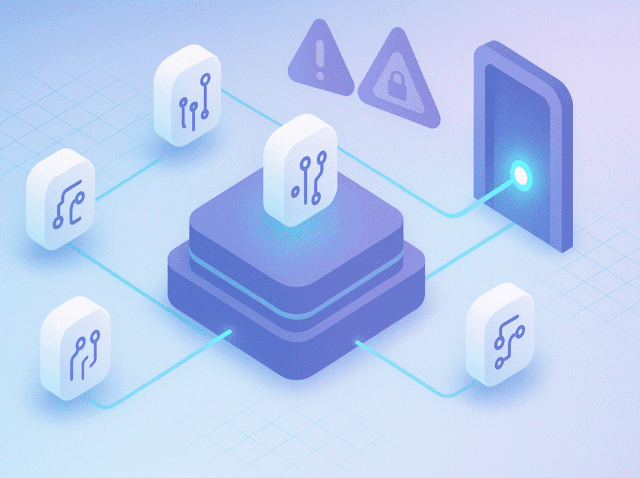Enable Secure Deployment of AI Agents
Deploy AI agents with guardrails that control access, protect data, and reduce risk
AI agents are designed to act on behalf of users. They carry out instructions, call APIs, interact with enterprise applications, and connect to external services. In many cases they can string together multiple steps to complete a workflow, passing data across tools and systems without human involvement. This ability to act autonomously is what makes them powerful, but it also creates new points of exposure that security teams need to account for.
Agents are often given broad or misconfigured permissions, which allows them to access data and applications outside of their intended scope. Malicious prompts or manipulated inputs can alter their behavior and cause them to execute actions outside of their intended purpose. As AI agents connect to third-party tools and external APIs, the dependency chain grows, and a weakness in any one of those services can ripple back into the environment.

Challenges and Security Risks of AI Agents
AI agents operate with autonomy, access, and evolving contexts, and that creates risk vectors that traditional controls often don’t cover. Failing to address these risks can lead to breaches, compliance violations, and loss of trust.
- Agents can create unintended outcomes even without direct attacks, through misuse of tools or poorly designed instructions
- Weak identity and authentication controls allow spoofing, impersonation, or broad credentials to be abused
- Visibility gaps mean organizations often don’t know what data agents are touching or which tools they are chaining together
- Poorly scoped permissions or legacy system integrations give agents access far beyond what they need
- Indirect prompt injection hidden in external content or chained tools can manipulate agents into unsafe actions
How Acuvity Secures AI Agents
Want the technical details on how Acuvity secures AI agents?
Get the full breakdown:

Agent Behavior Analysis and Guardrails
Acuvity evaluates how agents invoke tools, call functions, and interact with external services. It uses behavior analysis to spot misuse or deviations from expected workflows and applies guardrails to prevent escalation or unsafe actions.
Role-Based Agent Controls
Acuvity enforces least-privilege access for AI agents, tying their permissions to their defined purpose, user identity, and risk context. Agents are restricted so they only perform actions necessary for their role.
Agent Risk Scoring and Policy Tuning
Agents evolve over time. Acuvity tracks those changes, updates risk profiles accordingly, and adapts enforcement policies when agent behavior, tools, or external dependencies shift.
FAQAI Agent Security FAQs
What is AI Agent Security and Why Do Organizations Need It?
AI agent security refers to the comprehensive protection of autonomous AI systems that can execute tasks, access data, and interact with enterprise applications on behalf of users. Unlike traditional AI tools that simply generate responses, AI agents take actions. They call APIs, access databases, integrate with third-party services, and can chain together multiple operations to complete complex workflows without human oversight.
Organizations need AI agent security because these systems introduce unprecedented risks. Agents operate with elevated permissions to perform their functions, creating potential attack vectors that traditional security controls weren’t designed to handle. They can access sensitive data across multiple systems, execute financial transactions, modify configurations, and interact with external services. All of this happens based on instructions that could be manipulated through prompt injection or social engineering attacks.
The autonomous nature of AI agents means that security failures can cascade rapidly across connected systems. A compromised agent can actively execute malicious commands, alter business processes, or provide unauthorized access to enterprise resources. As organizations deploy agents at scale, the attack surface expands exponentially, making comprehensive agent security essential for maintaining operational integrity and regulatory compliance.
Modern enterprises require agent security frameworks that provide real-time monitoring, contextual access controls, behavioral analysis, and automated threat response to ensure these powerful systems operate within intended boundaries while delivering their promised business value.
How Do AI Agents Create New Attack Vectors That Traditional Security Can't Address?
AI agents fundamentally change the threat landscape by introducing dynamic, context-aware systems that can interpret natural language instructions and translate them into concrete actions across enterprise infrastructure. Traditional security models assume predictable, rule-based interactions, but agents operate with flexibility that can be exploited in novel ways.
Prompt Injection Attacks: Agents accept natural language input that can be manipulated to alter their behavior. Attackers can embed malicious instructions within seemingly legitimate content, causing agents to execute unintended commands, bypass security controls, or leak sensitive information. These attacks can be particularly sophisticated, using social engineering techniques to manipulate agent decision-making.
Tool Chain Exploitation: Agents typically integrate with multiple tools and services to complete tasks. Each integration point represents a potential vulnerability where attackers can manipulate the data flow between systems. If an agent connects to both internal databases and external APIs, a compromise in one system can be leveraged to attack others through the agent’s trusted connections.
Permission Escalation Through Autonomy: Agents often require broad permissions to function effectively, but traditional access controls can’t dynamically adjust based on context. An agent with database read access for reporting might be manipulated to extract data for unauthorized purposes, or an agent with API permissions could be tricked into making calls that exceed its intended scope.
Identity and Authentication Bypass: Agents act on behalf of users but may not maintain the same authentication rigor. Weak identity controls allow for spoofing, impersonation, or the abuse of service accounts with excessive privileges. When agents make calls to external services, distinguishing between legitimate and malicious requests becomes challenging.
Behavioral Unpredictability: Agents can exhibit emergent behaviors based on their training and context. This unpredictability makes it difficult to establish baseline security policies or detect anomalous activity using conventional monitoring tools.
These new attack vectors require security approaches that understand agent behavior, monitor natural language interactions, enforce dynamic access controls, and provide real-time threat detection across the entire agent ecosystem.
What Are the Most Critical Security Risks When Deploying AI Agents in Enterprise Environments?
Enterprise AI agent deployments face several critical security risks that can result in data breaches, compliance violations, operational disruptions, and financial losses. Understanding these risks is essential for developing effective security strategies.
Data Exfiltration and Leakage: Agents often access sensitive enterprise data to perform their functions, including customer records, financial information, intellectual property, and confidential business documents. Without proper controls, agents can inadvertently or maliciously share this data with unauthorized parties, external services, or through manipulated outputs. The risk is amplified when agents work with unstructured data or when their responses can be engineered to reveal sensitive information.
Compliance and Regulatory Violations: Agents operating in regulated industries must adhere to strict data handling requirements like GDPR, HIPAA, PCI DSS, and SOC 2. Uncontrolled agent behavior can lead to violations through unauthorized data access, improper data retention, cross-border data transfers, or inadequate audit trails. The autonomous nature of agents makes it challenging to maintain the detailed compliance documentation that regulations require.
Supply Chain and Third-Party Risks: Enterprise agents typically integrate with numerous external services, APIs, and tools to deliver functionality. Each integration introduces dependencies on third-party security practices, data handling policies, and service availability. A security incident at any connected service can compromise the entire agent ecosystem, and organizations often lack visibility into these external risk factors.
Identity and Access Management Failures: Agents require sophisticated identity management to operate securely, but many deployments rely on overprivileged service accounts or inadequate authentication mechanisms. This creates opportunities for credential theft, impersonation attacks, or unauthorized access escalation. When agents act on behalf of multiple users, maintaining proper identity context becomes complex.
Operational and Business Logic Attacks: Agents can be manipulated to execute inappropriate business actions. They might approve fraudulent transactions, modify critical configurations, or disrupt business processes. These attacks can cause direct financial damage and operational disruption while being difficult to detect using traditional monitoring approaches.
Shadow AI and Governance Breakdown: Without proper oversight, teams may deploy unauthorized agents or modify existing agents in ways that bypass security controls. This creates shadow AI deployments that lack proper security configurations, monitoring, or compliance alignment.
Addressing these risks requires comprehensive security frameworks that combine technical controls with governance processes, continuous monitoring, and incident response capabilities specifically designed for AI agent environments.
How Can Organizations Gain Complete Visibility Into AI Agent Behavior and Data Access?
Gaining complete visibility into AI agent behavior and data access is critical for maintaining security, ensuring compliance, and managing enterprise risk. AI agents operate dynamically, making decisions and accessing resources based on evolving contexts that can be difficult to track without specialized monitoring capabilities.
Comprehensive Agent Activity Monitoring: Organizations need real-time visibility into every action agents take, including which APIs they call, what data they access, how they process information, and what outputs they generate. This requires monitoring systems that can capture and analyze natural language interactions, track decision-making processes, and maintain detailed logs of all agent operations across distributed enterprise environments.
Data Flow Tracking and Classification: Understanding what sensitive data agents touch is essential for both security and compliance. Effective visibility solutions automatically classify data as agents interact with it, track data movement across systems and services, monitor for unauthorized access to sensitive information, and provide real-time alerts when agents handle regulated data like PII, financial records, or health information.
Multi-Modal Interaction Monitoring: Modern agents handle documents, images, audio files, and other data types that can contain sensitive information. Comprehensive visibility requires monitoring capabilities that can inspect and classify all forms of data that agents process, understand the context and sensitivity of different information types, and detect when sensitive data might be inappropriately shared or exposed.
Cross-Platform Agent Discovery: Many organizations struggle with shadow AI deployments where teams implement agents without central oversight. Complete visibility requires automated discovery capabilities that can identify all AI agents operating across the enterprise, catalog their capabilities and permissions, assess their security configurations, and maintain an up-to-date inventory of agent deployments and their associated risks.
Integration and Dependency Mapping: Agents typically integrate with numerous internal systems and external services, creating complex dependency chains that can be difficult to visualize. Effective monitoring solutions provide comprehensive mapping of agent integrations, track all third-party services and APIs that agents access, monitor the security posture of connected services, and identify potential risk propagation paths across the agent ecosystem.
Contextual Behavioral Analysis: Understanding why agents make specific decisions is crucial for detecting anomalies and ensuring appropriate behavior. Visibility solutions should capture the context surrounding agent actions, analyze decision-making patterns over time, identify deviations from established behavioral norms, and provide insights into agent reasoning processes that security teams can use for risk assessment.
User and Identity Attribution: When agents act on behalf of users, maintaining clear attribution is essential for accountability and compliance. Complete visibility requires tracking which users initiated agent actions, understanding the identity context of agent operations, monitoring for unauthorized access or impersonation, and maintaining clear audit trails that connect agent actions back to responsible parties.
Organizations that achieve complete agent visibility can make informed security decisions, demonstrate compliance with regulatory requirements, and confidently scale their AI agent deployments while maintaining appropriate risk management controls.
What Security Controls and Monitoring Should Be in Place for Production AI Agent Deployments?
Production AI agent deployments require comprehensive security controls and monitoring capabilities that address both traditional cybersecurity concerns and AI-specific risks. These controls must operate in real-time to match the speed at which agents make decisions and take actions.
Real-Time Input Validation and Prompt Filtering: All inputs to agents must be validated and filtered to detect potential prompt injection attacks, malicious instructions, or manipulated content. This includes implementing natural language processing security tools that can identify suspicious patterns, maintaining blocklists of known attack vectors, and using machine learning models to detect novel injection attempts before they reach agent processing systems.
Output Monitoring and Content Filtering: Agent outputs must be continuously monitored for data leakage, inappropriate content, compliance violations, and potential security risks. Organizations should implement automated scanning for sensitive data patterns, content classification systems that flag problematic outputs, and real-time redaction capabilities that protect sensitive information from unauthorized disclosure.
API and Integration Security Controls: Since agents interact with numerous external services and APIs, organizations need comprehensive API security monitoring that tracks all agent-initiated connections, validates API authentication and authorization, monitors for unusual access patterns, and maintains an inventory of all third-party integrations with associated risk assessments.
Behavioral Analytics and Anomaly Detection: Production deployments require sophisticated monitoring systems that establish behavioral baselines for each agent and can detect anomalies that might indicate compromise, misuse, or malfunction. This includes tracking communication patterns, analyzing decision-making processes, monitoring resource utilization, and identifying deviations from established operational parameters.
Access Logging and Audit Trails: Every agent interaction must be logged with sufficient detail to support security investigations and compliance requirements. This includes maintaining records of all data accessed, actions taken, external communications, user contexts, and decision rationales. Log data should be tamper-proof, searchable, and integrated with broader security information and event management (SIEM) systems.
Incident Response and Automated Remediation: Organizations need incident response procedures specifically designed for agent-related security events, including automated capabilities to isolate compromised agents, revoke access permissions, terminate suspicious sessions, and notify security teams of potential threats. Response procedures should account for the cascading effects that agent compromises can have across interconnected systems.
Performance and Availability Monitoring: Security controls themselves must be monitored to ensure they don’t degrade agent performance or availability. This includes tracking the performance impact of security scanning, monitoring for false positive rates in threat detection, and ensuring that security controls scale appropriately with agent usage volumes.
Compliance and Regulatory Monitoring: Automated systems should continuously assess agent behavior against applicable compliance requirements, generate compliance reports, maintain evidence for audit purposes, and alert administrators to potential violations before they result in regulatory issues.
These controls must be integrated into a cohesive security framework that provides comprehensive protection while enabling agents to deliver their intended business value efficiently and reliably.





